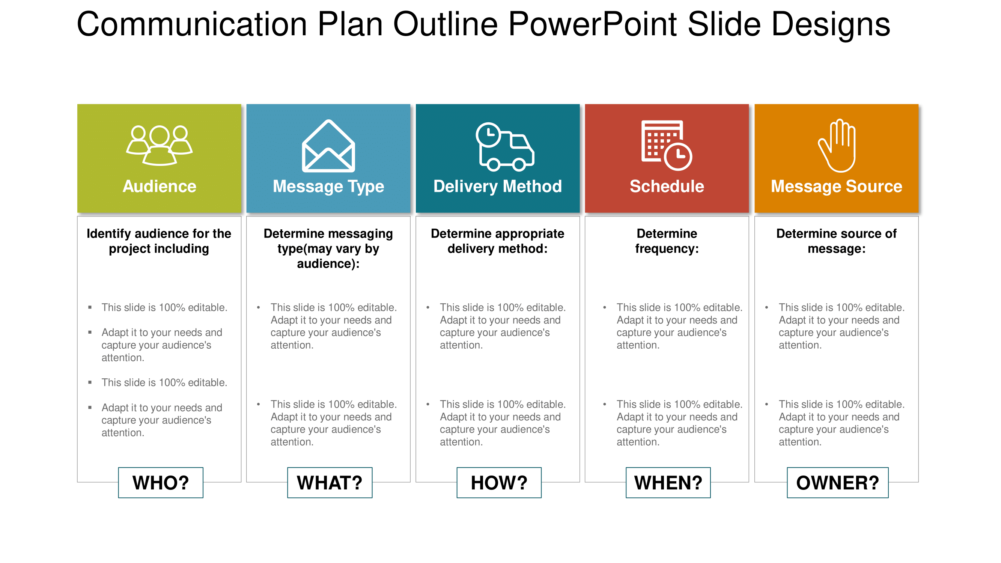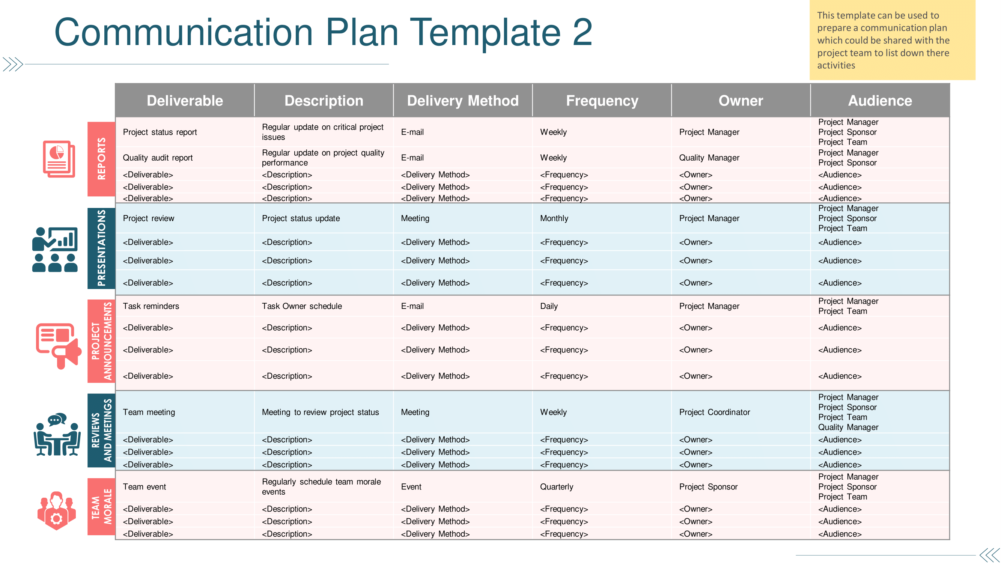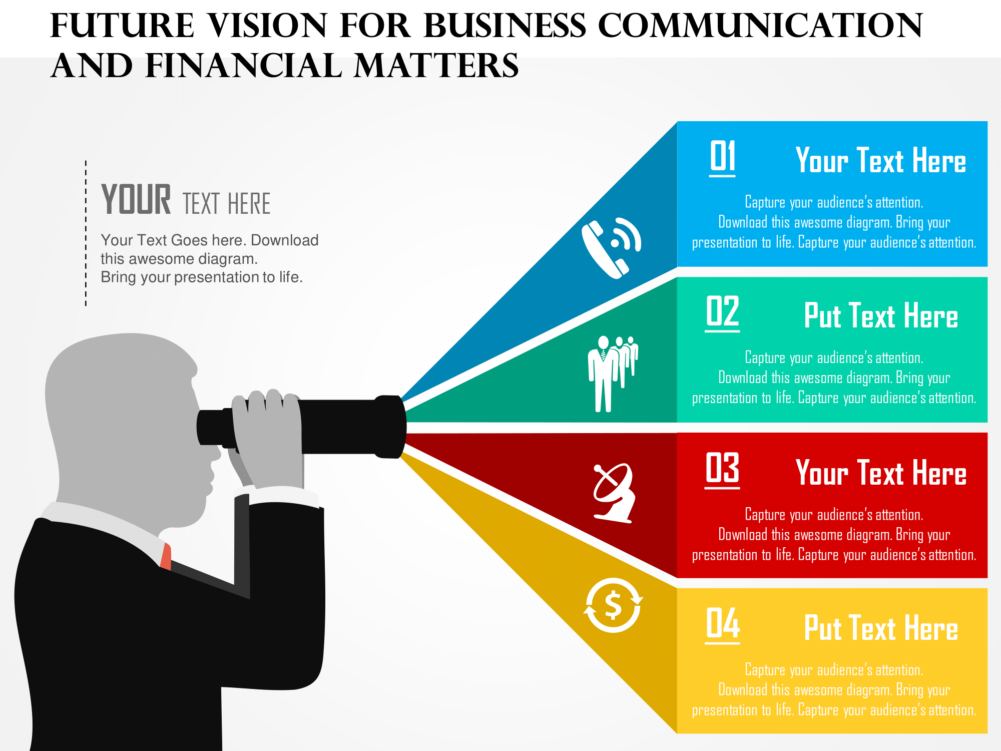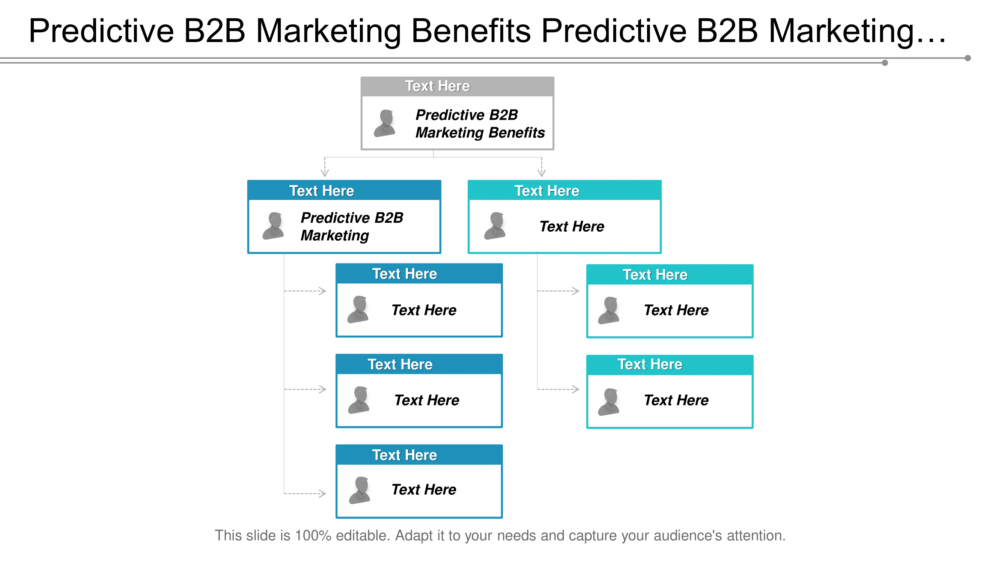Remember the time when popular fast food giant KFC used negative reviews of customers on Twitter regarding its new fries to improve and promote the fries instead? The ad campaign gathered such media mileage that it turned KFC (not even remotely known for its fries) into a creative advertiser that other brands emulate. An idea so delectable that it is finger lickin’ good, right?
But do you know what goes behind the wheel of such a mind-bending move by companies the size of Kentucky Fried Chicken? Who decides and implements this relay of message that ultimately reaches us online or through personalized emails? What goes behind such decisions that makes large conglomerates put out these messages with such precision and impact? A well-devised communication plan, that’s what!
For the uninitiated, a communication plan is the roadmap via which your message gets delivered to the intended stakeholders. The plan charts who will communicate the message, to whom it will be delivered and via what communication channel. For any company, whether it is launching a new product or tendering an apology via social media to acquiesce a backlash from its followers, a carefully structured communication plan can make or break brand image (or avoid lawsuits, too!). In fact, a communication plan is the most crucial cogwheel in its functioning as a brand.
With brands and entrepreneurs making waves in our daily lives, we cannot deny how imperative it is for any functional business to leverage a communication plan to carry out an effective transmission of messages and enhance their brand presence. Not only does a communication plan hold the power to gain media impact, but it also helps make critical decisions that help in customer engagement and retention. We shall discuss the what, how and why of communication plan in this blog (there are five of our most popular templates to download as well). Read on:
Components of a communication plan
Protocol is the lifeblood of any kind of organization. A comprehensive communication plan validates such protocols for response to any activity pertaining to the organization. The crisper the communication plan, the better the progression of company actions and values. A key catalyst for brand communication, a communication plan consists of the following components:
- Company message
- Audience
- Communication channel
- Communication goal
- Message criticality
- Message sender
- Message frequency
#1 Company message
The biggest entity of a communication plan is the company message. It stands for the statement that a company wants to put out with respect to a particular activity pertaining to the business. Basically, it is something that a company stands for and what it does with its efforts and values. Your company message can be transmitted using a communication plan effectively. It will tell the appropriate stakeholders what is going to happen regarding a particular situation of the company. Before drafting a proper company message, you need to take stock of every aspect of a particular event related to your business. Take a look at this simple plan from our collection for example:
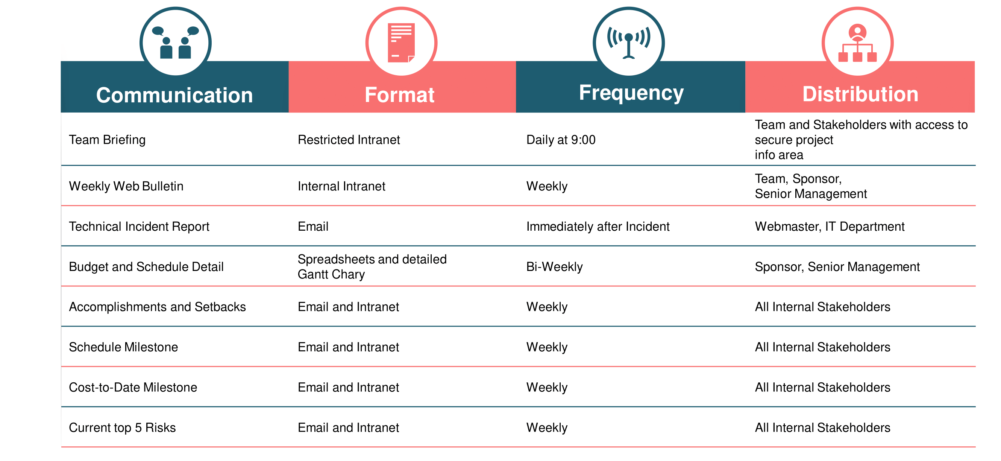
If it is a product launch, for instance, you need to chalk out the various levels of the organization for notifying them as per your communication plan. When you launch the product, you have to specify it to the target audience about what your intentions are regarding the product and how it will make an impact. Mostly, you can devise a company message much before the product launch. On the other hand, if you have faltered at some point in your service, you need to set things straight with an appropriate apology (if applicable) and then gauge the customer response. Such responses can only be elicited when you have got a robust and flexible communication plan that has the layout specific to the task being undertaken.
#2 Audience
If you are devising a communication plan, you have to keep the audience in mind. Who is the person you are communicating this message to? Whom does your action impact? With a clear idea of an audience in mind, you can make your message heard with your communication plan. With people interacting with businesses more via online mode or electronic mode, the audience for the company message is getting more and more vast and dynamic. So a communication plan must have a descriptive idea about taking care of the needs of this dynamic audience.
For that, a communication plan has a designated spot for the end point of each message transmission. The KFC move, for instance, was intended to captivate the audience on Twitter, a global online platform with the capacity of making things viral or trending. The intended message of promoting the fries was generated from Twitter and was aimed back at the audience on the social platform.
#3 Communication channel
If we talk of the message and the audience, there has to be a channel to relay that message to that audience. For a company, it is crucial to have a tailored plan that suits its needs via electronic as well as non-electronic channels of communication. With electronic communication, you can leverage email, digital content and social media platforms to convey your message. As for non-electronic mode, you have outdoor advertisements, newspaper announcements and brochures. While formatting a communication plan, experts always focus on the impact needed while transmitting the message. For that, they choose the more quick and interactive channels like social media platforms to reach out to the maximum audience.
Choosing the right communication channel will always keep you ahead while setting your business goals. It will set you apart from your competitors as well. Another upside to having a good communication plan with specific channels is that it will help you mitigate issues as and when they occur.
#4 Communication goal
With each communication plan, you tend to achieve a certain benchmark. Communication goal comprises the intended result of your chain of messages. Basically companies establish these goals as specific and quantifiable milestones that are to be achieved in a specific time frame. You do not have to worry about achieving results if you plan the goals in advance. That is why, communication goal is a key part of every level of communication plan that you draft for your organization.
The strategy here is to set goals that are specific (achieving signups for a new product), measurable (100,000 signups), attainable (not infinity and beyond), relevant (achieve the results you plan as per the business) and time-bound (100,000 signups in eight months), or SMART, if you will. With setting of such goals, your objectives become clear. If you draft a communication plan, it must have these objectives clearly defined.
#5 Message criticality
Now suppose if an advertisement you put out has elicited a lot of backlash for its tone. In that situation, how you respond to that backlash shows the character of your company. In a communication plan, the urgency of the message that you put out reflects on that character. Therefore, the criticality or urgency level of the message also forms a key part of a company’s communication plan. With each level of criticality, you get to assign a certain level of action to be taken to address a potential risky situation as well. Having such levels helps in quicker grievance redressal as each message is addressed by a designated employee of the company. Streamlined communication aids smoother business processes.
#6 Message sender
Once you have denoted a level of criticality for a message, you have to appoint an individual to relay that message through the appropriate communication channel. Therefore, a communication plan must have a “Sender” column for each type of message. Ideally, the messages with high urgency should be assigned to top level of the management. If you have strong social media interaction of the upper management or CEO with the audience, then high criticality messages can be addressed by them. This comes in handy when a particular risk can be damaging to the company reputation. Having a designated individual handle the communication points can enable better risk and reputation management.
#7 Message frequency
Once you have decided how you are going to tackle a situation with the communication plan, the idea is to decide how often you will put out the message. For instance, for a product launch, you can start off by putting out teaser videos and images on social media. This will generate the engagement about your product. Thereafter, you can move on to larger frequency of posts about the product features and advertisements. Once you decide the frequency in your communication plan, you are able to develop your advertisement and outreach campaigns in a more streamlined manner.
While you decide the frequency, you must take care of the fact that frequency also depends on the influence of each message sent out to the audience. If the frequency is high, then you must schedule your messaging so as to not overwhelm the audience about it. While using non-electronic mode of communication, you must target a specific time span to let your audience know about your product.
Significance of communication plan
Now, onto the pressing question! Why does your company need a communication plan? What will a communication plan do for a new tech startup? Or how does it matter for a huge business just starting with its social media presence? The answer is simple. Communication is the metaphorical oxygen for a company. If we look at it from the customers’ standpoint, having an agile communication plan helps you maintain a methodical connect with them. Having a communication plan gives you the following advantages:
- It gives structure to your workflow: Clearly, having a communication plan puts your organization workflow in a strategic mold. It takes your efforts from random to focused. And these focused efforts enable smoother operations and better achievements.
- It makes your workforce inclusive and creative: Designating employees for each level of a communication plan helps you make the workforce more inclusive and full of varied ideas to approach a situation. Got a general issue regarding a product launch? Bring in the manager as well as the intern into the communication plan to have as many ideas as you can.
- It helps you manage risks: A scathing tweet from a disgruntled customer? How will you ensure prompt action? By ensuring that the social media manager knows who to convey this information to and what steps follow to address the customer grievance. That is where a precise communication plan trumps an unorganized system. And since no business runs without risks, it makes sense to have a tool to address all levels of risk that you may encounter online or offline.
- It improves your brand image: Having a communication plan to interact with your audience builds customer trust. Since the modern as well as older generation looks for solution to their problems online, a communication regimen will enhance your brand image, irrespective of whether you are approaching the B2B or B2C side of it. A communication plan also sets you apart from the competition in the matter of customer engagement and retention.
- It sets quality benchmarks: And by benchmarks, we mean measurable entities that govern how you operate your internal as well as external communication channels. A communication plan also ensures seamless integration of employees into a workable system of self-management. Assigned roles make it easy for each level of the communication plan to deliver on their KRAs within the organization.
Get started with some of our most downloaded communication plan templates
Time to get things in order! Having a well-structured communication plan can make your tasks easy. Therefore, we are listing here five of our most downloaded communication plan templates that have changed the dynamic for our clients. Try these and incorporate them into your communication strategy to get the best results.
Template 1
The beauty of this communication plan template is that it brings all the necessary components into a tabulated form that is easy to follow. So when you need to implement your communication strategy for a smooth transmission of company messages, simply mark the components as per your requirements and put this plan in place. It will be easy for your executives as well as managerial layer to execute.
Template 2
Want a functional communication strategy template that you can get started with right away? Try this succinct template that is also the ones that companies have loved. In fact, the major components are highlighted for you to keep track. You can print this plan out to make even a layman understand who is communicating what to whom. It also factors in the deliverables to let you accomplish your goals in a hassle-free way.
Template 3
If minimal and colorful is your thing, then include this ‘straight to business’ communication strategy that has featured in our ‘most downloaded’ list. You can convey the future vision of your business and financial matters while keeping your team up to speed with what is expected of them. The simple image is easy to follow and implement. Introduce your new employees to the way things work with this template.
Template 4
What’s more decipherable than lines and lines of text? A three-stage graphic, of course! The catch is that you can specify the communication points in this predictive plan for your marketing efforts. It will be easy for your team to incorporate into their daily functioning. Make your workflow more definitive and engaging for fruitful communication effort. This template, just like the ones listed, is fully editable so that you can have tailored plans for information relay.
Template 5
Capture the essence of developing pioneer products with this elaborate project communication outline. This template serves the purpose of detailing the communication strategy at each level of project development. You can use this template to outline all the components that you need for executing a successful business strategy. You can also remove the slides of graphics that you do not need (it’s 100% editable).
So there you have it. Get started with effortless business processes by having any our communication plan templates. You can also use our design services if you need help getting a communication plan with a fine cut.


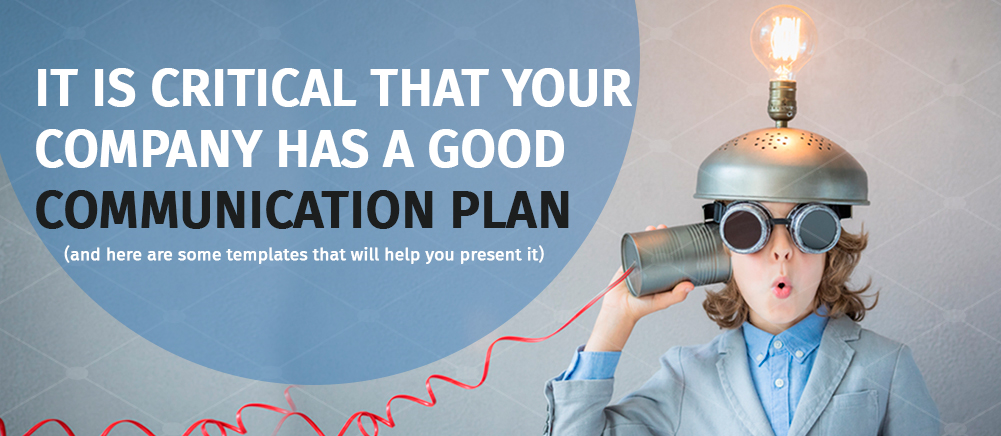


 Customer Reviews
Customer Reviews

